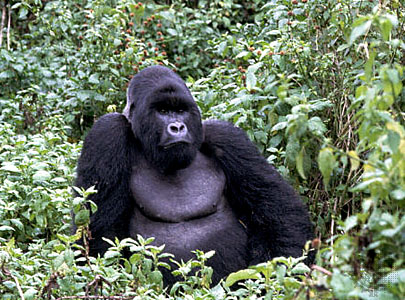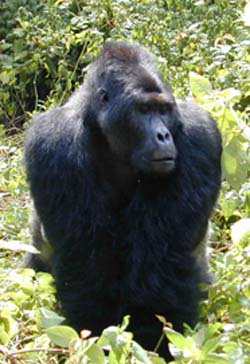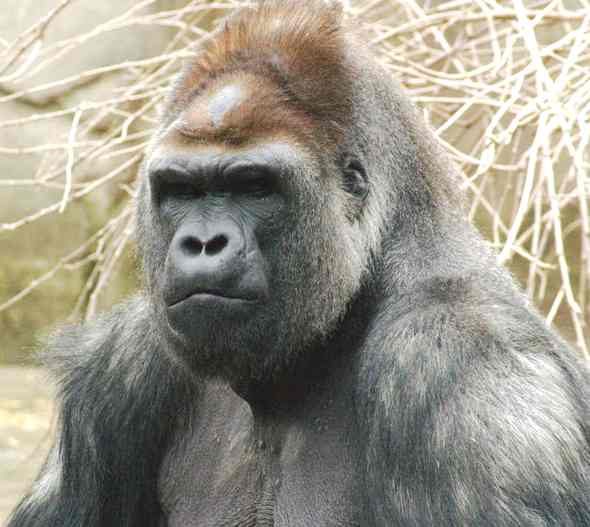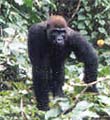New Gorilla Population Estimate Criticized
Posted by: Loren Coleman on August 5th, 2008
For years cryptozoological researchers have been questioned and criticized for estimating the population of large hairy unknown primates in North America, most often called Bigfoot and Sasquatch.
Now comes news that the world is excited by the findings from the Wildlife Conservation Society that the western lowland gorilla subspecies is estimated to be 125,000 animals strong.
Xihuanet news is reporting that wildlife researchers on Tuesday, August 5, 2008, announced a major increase in the population of lowland gorillas after a new census tallied more than 125,000 in an 18,000-square-mile (47,000-square-kilometer) deeply forested area of the Republic of Congo.
Estimates from the 1980s had suggested fewer than 100,000 of the great apes had survived and many experts believed these numbers had been cut nearly in half by disease and hunting.
“This is a very significant discovery because of the terrible decline in population of these magnificent creatures to Ebola and bush meat,” said Emma Stokes, one of the research team.
How did they estimate the population, you ask? The researchers in the central African nation of Republic of Congo came up the population figures by counting the sleeping “nests” gorillas make. They reported that the gorillas themselves are too reclusive and shy to count individually.
Craig Stanford, professor of anthropology and biology at the University of Southern California, said he is aware of the new study. “If these new census results are confirmed, they are incredibly important and exciting, the kind of good news we rarely find in the conservation of highly endangered animals.”
But I have to raise the skeptical notion that this figure could be greatly overblown. Gorillas do not merely make a nest and stay there for life. Yes, while they sometimes re-use nests, they also move on and build new nests.
Would you estimate the human population (taking into account the homeless) by counting the number of homes in an area? How would you estimate the multiple users of one dwelling? The empty houses? The moving of one family to other houses?
I question the methodology (as it is so casually explained in the mass media) in this gorilla study, and wonder if the under-estimates in the Sasquatch numbers might be more on-target than this “exciting news” on a massive population explosion among the western lowland subspecies of gorilla. Counting nests to come up with a firm overall population figure seems, well, a bit shaky.
Western lowland gorillas are one of four gorilla subspecies, which also include mountain gorillas, eastern lowland gorillas and Cross River gorillas. (Some dispute exists about whether the mountain gorilla may be a full species, not a subspecies.) All are labeled either endangered or critically endangered by the International Union for Conservation of Nature.

Mountain gorillas have coloration and facial features that are quite different from the lowland gorillas (western, eastern, Cross River, and Grauer’s).

Grauer’s gorilla, which are said to be a subspecies of the eastern lowland, although, of course, the eastern lowland gorilla is already a subspecies.

Eastern lowland gorilla features a distinctive red crown, often seen in zoos).

Western lowland gorillas also show the red crown.

With only 200 in their entire population, the Cross River gorilla is rarely photographed in the wild.

Closeup of the Cross River gorilla’s face.

It is a common public misconception that older silverback males are only found among the mountain gorillas. This is a western lowland gorilla.

Some rather unique color phases are found among gorillas, such as this “browning out” in this male apparent western lowland zoo specimen.
What is also intriguing, of course, is the appearance of a definitely pointed head, much as described from the sightings of some Yeti and Sasquatch.
But not for the Bili ape.
About Loren Coleman
Loren Coleman is one of the world’s leading cryptozoologists, some say “the” leading living cryptozoologist. Certainly, he is acknowledged as the current living American researcher and writer who has most popularized cryptozoology in the late 20th and early 21st centuries.
Starting his fieldwork and investigations in 1960, after traveling and trekking extensively in pursuit of cryptozoological mysteries, Coleman began writing to share his experiences in 1969. An honorary member of Ivan T. Sanderson’s Society for the Investigation of the Unexplained in the 1970s, Coleman has been bestowed with similar honorary memberships of the North Idaho College Cryptozoology Club in 1983, and in subsequent years, that of the British Columbia Scientific Cryptozoology Club, CryptoSafari International, and other international organizations. He was also a Life Member and Benefactor of the International Society of Cryptozoology (now-defunct).
Loren Coleman’s daily blog, as a member of the Cryptomundo Team, served as an ongoing avenue of communication for the ever-growing body of cryptozoo news from 2005 through 2013. He returned as an infrequent contributor beginning Halloween week of 2015.
Coleman is the founder in 2003, and current director of the International Cryptozoology Museum in Portland, Maine.










I totally agree with you on the fact that this study is very questionable. I can’t understand how any educated person would think that this is a good way to do a count.
It occurs to me that we have thermal imaging technology. Why couldn’t several fly-overs be done with thermal imaging devices to seek out the heat signatures of gorillas? I know there might be some confusion with other animals, but it would seem this might produce a more accurate count than counting nests.
Do gorillas have similar body temperatures to other animals in the region (including humans)? Perhaps the temperature could be read to distinguish them.
I heard this story on the Radio this morning driving to work (on NPR), very interesting (and promising), however I agree, looking at it more logically, the method of counting could have been better. Granted the scientist were performing this count in one of the most unforgiving areas known to man (they said there wasn’t even a dry place to pitch a tent, all swamp) and did the best they could. They did suamrize in the story i heard that yes, their count could be inflated, but their conservative estimate (i forget the number) still places a large number of Gorillas in the area which is always promising. They also spoke about getting the “Green Abyss” turned into a wild life park so it remains untouched by us (other than for studies).
Well, yeah that’s pretty shaky, but it sounds like the only way to get some kind of ballpark figure. There must be some fluctuation in the number of nests observed from year to year, at least enough to get an idea of whether the population is growing or declining.
I don’t know. With limited resources, I’m not sure how else they could even make a guess at a number.
Incidentally, what do gorilla nests look like?
The flyover would do the same thing… raise questions. Either way you do it (unless you count and number each gorilla, which I doubt you’ll never find each one) people will dispute it.
Trying to tell what animal you’re looking at on a thermal image is more difficult than pointing out a mangy bear. And we all know how hard that is… 😉
I think it is a little early to criticize this technique without knowing more specifics about their methodology. Biologists use indirect indicators like nests to create a population “index,” which they calibrate using more direct measures of population size. For instance, if you know exactly how many gorillas live in a certain area (say, a small reserve), you can count the number of nests in that area, and determine how nest numbers correlate with actual population size. Then you can apply that correlation to an area for which only the number of nests is known. I would be very much surprised if these biologists were simply assuming some crazy one-to-one relationship between nest number and gorilla number, or were not taking into account the age of the nests they found, or the frequency with which gorillas make new nests. Obviously, if these factors really were ignored, then it would be perfectly valid to criticize this technique. But judging the merits of the study based on a newspaper article is hardly fair to the scientists involved, as technical details like these are often not included in pieces written for the general public. Jeff Meldrum has experienced similar criticisms of his work, because skeptics judge the quality of his science based on what they read in a paper or see in a documentary. This is not an accurate way to assess a scientist’s work, since 90% of the details have probably been boiled down into simple sound bites.
I could not agree with EEB more. I look forward to reading the formal scientific discussion of the methodology. In the meantime, I figured a critical reading of the “excited” media notices might be in order here.
BTW, I’ve updated the posting with various images of the subspecies of gorillas. Earlier readers might wish to check back to view these.
i do not post much, but ive been coming to this site religiously for years now. i just want to point out how sad the animals in the zoo are.. they look like they have given up.
being a avid fan of cryptids i am also a fan of animal rights.
i feel for these gorillas.
Sooo….the lowland gorillas are more shy than the mountain gorillas? How was Goodall and her team able to get so close to the mountain gorillas? Look, even in human society, if you counted the number of nests, you would have to prove that that nest was used once during your time counting. Besides, how many different family units are there? If the hunting has decreased it’s probably because the men are being “drafted” in the continuing fighting over there. That area is the closest we have to hell on earth.
EEB is correct.
Staticticians would see this as a basic scenario, factoring in variales and coming up with a number. The more data they had to go on the more accurate the number would be.
The questions are what variables are being fatored into the numbers and what would be the cause of the rise in staed numbers?
Good post, Loren!!!
I was WOW when I saw that last picture. That really looks like the pointy scalp the yeti is supposed to have. This leads even more credence to the yeti being a great ape.
I was like WOW when I saw that last picture. That really looks like the pointy scalp the yeti is supposed to have. This leads even more credence to the yeti being a great ape.
I have an earth shaking suggestion. Let’s just leave them alone and focus on protecting them and their habitat. Without all of that the numbers will obviously go down anyway.
It would be interesting to know whether the methodolgy which was used to calculate the earlier population estimates was the same as that used to obtain the more recent, updated ones. If so, then the difference between the previous results and the current ones would indeed be significant.
I don’t remember ever reading about Jane Goodall doing field research with Gorillas, although her work studying chimpanzees is well-known. The late Dian Fossey conducted very important field research on Gorillas, and I understand that her activism toward protecting these magnificent creatures and their habitat may have led to her untimely death.
I wonder if there have been updates on the possible taxonomy of the Bili apes. The last I remember rading about them was that DNA testing seemed to suggest that they may be a type of chimpanzee; although their morphology and behavior is quite different.
Good afternoon Cryptos…
Thank you, Loren…finally some good news we can use…
live and let live…
ole bub and the dawgs
EEB took the words right out of my mouth. Good post and good understanding of census techniques.
Absolutely I agree. Don’t be too quick to criticize scientific census techniques based on what is seen in newspapers, mainstream magazines, or something on the Discovery Channel. While these can be somewhat informative, the media can seriously dummy down complex scientific methodologies for the understanding of the layperson. It is not always an accurate portrayal. I’ve been known to shake my head and groan at some representations of these in the media. I’d be interested myself to see the formal description of their techniques before saying too much.